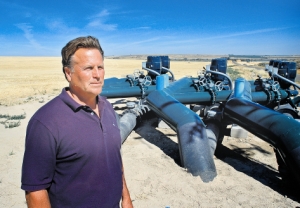forum
library
tutorial
contact

Idaho Power Irrigation Incentive
Program Participation Increases
by Kerri Sandaine
Capital Press, August 21, 2018
|
the film forum library tutorial contact |

|
Idaho Power Irrigation Incentive
by Kerri Sandaine
|
Tight labor, S.E. Oregon water supply boosting demand
 Idaho Power Co. in each of the last three years spent more to help irrigators upgrade or replace equipment, and is on track to see more gains in 2018. The Boise-based utility is sending proportionately less electricity to these customers, one of the program's goals.
Idaho Power Co. in each of the last three years spent more to help irrigators upgrade or replace equipment, and is on track to see more gains in 2018. The Boise-based utility is sending proportionately less electricity to these customers, one of the program's goals.
Participants in the Irrigation Efficiency Rewards program can receive cash incentives for a portion of the cost to install a new, more efficient system or to make energy-efficiency improvements to existing infrastructure. Company officials say demand has been increasing largely independently of year-to-year changes in water supplies and crop prices. A bigger factor appears to be a tight supply of skilled labor.
"This year's participation is significantly above expectations," said Dan Axness, who coordinates Idaho Power's irrigation customer segment. "If we continue at the same rate, we will exceed last year's incentive savings and payments."
Idaho Power paid 33 percent more in incentives to irrigators in 2016 compared to 2015, and 0.35 percent more last year compared to 2016. Energy savings -- the amount of electricity the company would have supplied irrigators if the upgrades weren't in place -- grew more than 12 percent between 2015 and 2016, and by 7 percent between 2016 and last year.
Irrigators in 2015 used about 2.05 billion kilowatt-hours of electricity, and the program saved 14.03 million kilowatt-hours, paying about $1.5 million in incentives, according to Idaho Power data. Irrigators accounted for more than 14 percent of the utility's total load that year, Axness said. A kilowatt is 1,000 watts. The average home uses about 950 kilowatt-hours per month.
From 2016 to 2017, the amount of saved energy increased from 15.75 million kilowatt-hours to nearly 16.9 million. Incentives paid increased from $2.007 million to $2.014 million. Irrigation usage dropped from 1.95 billion kilowatt-hours to 1.77 billion.
| Year | Energy (MWh) |
Averaged Annually |
Incentive |
|---|---|---|---|
| 2015 | 2,050,000 | 234 aMW | $1,500,000 |
| 2016 | 1,950,000 | 223 aMW | $2,007,000 |
| 2017 | 1,770,000 | 202 aMW | $2,014,000 |
So far this year, Idaho Power has realized irrigation-related energy savings of 12.28 million kilowatt-hours and spent about $1.42 million on incentives.
Many irrigators install or upgrade systems outside irrigation season, so more growth is likely this year, Axness said. "While you're doing it is a good time to think about improving it," he said.
A short supply of skilled labor is a bigger driver of demand than year-to-year changes in water supply and even in crop prices, Axness said.
Water supply in Idaho Power's service territory was lower than average two years ago, well above average last year -- reducing Idaho Power's irrigation-related electricity output, or load, he said -- and is around average this year except in southeastern Oregon. The company this year slightly increased the rates paid by Oregon non-residential customers including irrigators.
Axness said this year has seen more interest in Irrigation Efficiency Rewards projects in eastern Oregon, where the water content in several reservoirs is well below average.
"There is a continuing effort to have more water-efficiency projects in that area served by Owyhee Reservoir and others," he said.
"It seems like labor is driving things," Axness said. "The one thing we hear more than anything else is the labor savings."
As labor availability becomes more challenging, "we see more conversions from flood and wheel-line irrigation to center-pivot irrigation and a much smaller amount of drip irrigation," he said.
Idaho Power recently sees more irrigation projects on farms that are consolidating or expanding, and a fair number of projects on small acreages - whether it's a small farm converting to sprinkler irrigation or a small, possibly oddly shaped parcel where a center pivot is now viable due to technological advancements and labor shortages, Axness said.
"I often wonder how a porducer or irrigator can afford to do it, and they often say they cannot afford not to do it," he said.
Idaho Power has about 20,000 irrigation meters, or services. About 4,000 customers operate one meter each, and about 2,000 including many sizable agriculture producers operate the remaining 16,000, he said.
"Crop demands are so important and crop water use is so important that the year-to-year changes (in water supply) over the last few haven't appeared to be a factor" in demand, he said, notwithstanding this year's water-savings efforts in dry southeastern Oregon. Irrigation Efficiency Rewards participation rose even as alfalfa hay prices dropped in 2016 and '17, he said.
Idaho Power added 294 irrigation customers last year, a company fact sheet said. Its total customer base exceeds 547,000.
Related Sites:
Irrigation Efficiency Rewards by Idaho Power
learn more on topics covered in the film
see the video
read the script
learn the songs
discussion forum
